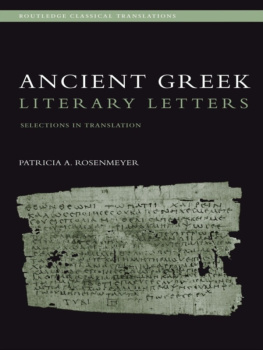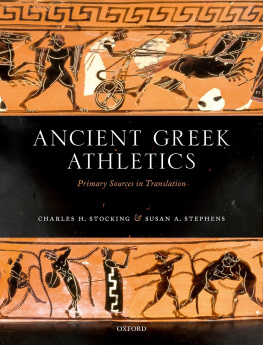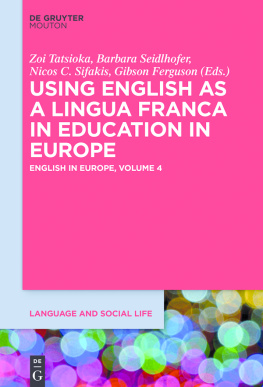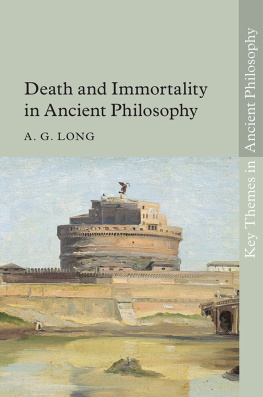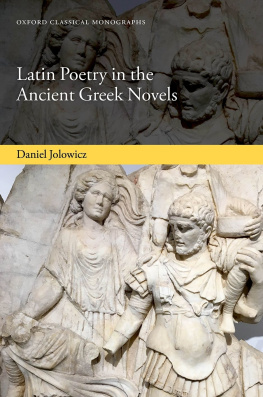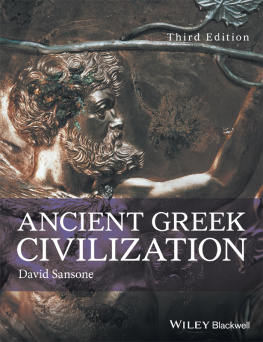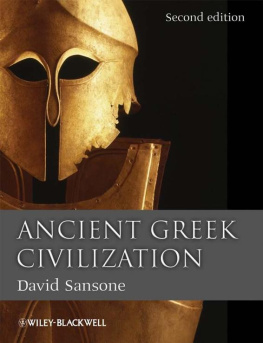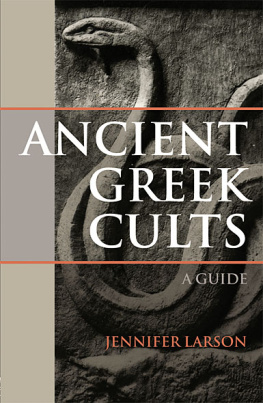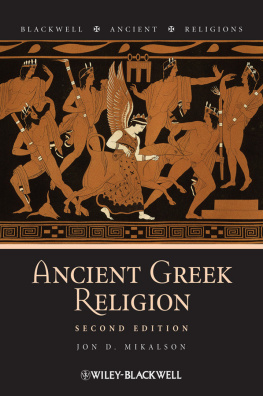Patricia A. Rosenmeyer - Ancient Greek Literary Letters
Here you can read online Patricia A. Rosenmeyer - Ancient Greek Literary Letters full text of the book (entire story) in english for free. Download pdf and epub, get meaning, cover and reviews about this ebook. year: 2011, publisher: Taylor and Francis, genre: Detective and thriller. Description of the work, (preface) as well as reviews are available. Best literature library LitArk.com created for fans of good reading and offers a wide selection of genres:
Romance novel
Science fiction
Adventure
Detective
Science
History
Home and family
Prose
Art
Politics
Computer
Non-fiction
Religion
Business
Children
Humor
Choose a favorite category and find really read worthwhile books. Enjoy immersion in the world of imagination, feel the emotions of the characters or learn something new for yourself, make an fascinating discovery.
- Book:Ancient Greek Literary Letters
- Author:
- Publisher:Taylor and Francis
- Genre:
- Year:2011
- Rating:4 / 5
- Favourites:Add to favourites
- Your mark:
- 80
- 1
- 2
- 3
- 4
- 5
Ancient Greek Literary Letters: summary, description and annotation
We offer to read an annotation, description, summary or preface (depends on what the author of the book "Ancient Greek Literary Letters" wrote himself). If you haven't found the necessary information about the book — write in the comments, we will try to find it.
Ancient Greek Literary Letters — read online for free the complete book (whole text) full work
Below is the text of the book, divided by pages. System saving the place of the last page read, allows you to conveniently read the book "Ancient Greek Literary Letters" online for free, without having to search again every time where you left off. Put a bookmark, and you can go to the page where you finished reading at any time.
Font size:
Interval:
Bookmark:

What was it about epistolarity that appealed so strongly to the Greek imagination?
The first reference in Greek literature to a letter occurs in our oldest extant Greek poem, Homers Iliad. But letters can be found lurking in every corner of ancient Greek writing. This book aims to bring the literary letters themselves into clear view for contemporary readers.
Many ancient writers included letters in other narrative genres: Euripides brought letters on stage; historians included letters as documents; Greek novelists sprinkled their stories with letters exchanged between separated lovers; and epigrammatists played with the epigram as letter. By the second and third centuries CE, many centuries after Homers epics, imaginative letters had evolved into an established genre in their own right: Aelian and Alciphron excelled in epistolary impersonations, imitating the voices of the lower classes, and collecting their letters in anthologies; Philostratus emerged as a master of epistolary spin, taking one theme and subtly tweaking it in half a dozen letters to different addressees; and anonymous writers competed with one another in their particular form of ghost-writing for the rich and famous.
Arranged chronologically, with introductory sections for each time period, this book studies a wide range of writers, genres and literary levels and suggests that there is more to a letter than just the information it communicates. Epistolary context is just as important as content, as will be rediscovered by Ovid, Richardson, Laclos, and a whole host of later European writers. Patricia A. Rosenmeyer has chosen a highly entertaining selection, which includes translation of previously inaccessible or untranslated works, and deftly opens up a neglected area of study to provide an enjoyable and significant survey for students of Greek epistolography.
Patricia A. Rosenmeyer is Professor of Classics at the University of Wisconsin-Madison.
First published 2006
by Routledge
2 Park Square, Milton Park, Abingdon, Oxon OX14 4RN
Simultaneously published in the USA and Canada
by Routledge
270 Madison Ave, New York, NY 10016
Routledge is an imprint of the Taylor & Francis Group
2006 Patricia A. Rosenmeyer
This edition published in the Taylor & Francis e-Library, 2006.
To purchase your own copy of this or any of Taylor & Francis or Routledges collection of thousands of eBooks please go to www.eBookstore.tandf.co.uk.
All rights reserved. No part of this book may be reprinted or reproduced or utilized in any form or by any electronic, mechanical, or other means, now known or hereafter invented, including photocopying and recording, or in any information storage or retrieval system, without permission in writing from the publishers.
British Library Cataloguing in Publication Data
A catalogue record for this book is available from the British Library
Library of Congress Cataloging in Publication Data
A catalog record for this book has been requested
ISBN10: 0-415-28550-X (hbk)
ISBN10: 0-415-28551-8 (pbk)
ISBN13: 978-0-415-28550-6 (hbk)
ISBN13: 978-0-415-28551-3 (pbk)
The original idea for this book came, most appropriately, in the form of a letter from Richard Stoneman; I have appreciated his encouragement and patience throughout the writing process. John Henderson supported this project from its earliest stages; his suggestions for improvement were gratefully received, as were those of the anonymous readers for the press. I have benefited from conversations with colleagues, students, and friends, including Kasia Hagemajer Allen, Philip Altman, William Aylward, Colleen Bayley, Kenneth Katz, Alexandra Pappas, Angela Pitts, Thomas Rosenmeyer, and Irene Ramalho Santos. Vasiliki Kostopoulou assisted with early drafts of several translations, and Patricia Hanson supplied wise counsel at critical moments. My research was made possible by a summer grant from the University of Wisconsin Graduate School Research Council, a Vilas Associates Award, and a sabbatical leave from the University of Wisconsin during the academic year 20042005.
I signed a contract for this book just after my daughter Sarahs first birthday; it will be in press as she begins to read and write. Her older brother Daniel already fully understands epistolary conventions, as well as the multiple uses to which letters may be put; his (deceptive) letter to the tooth fairy was a model of persuasive rhetoric, even if it eventually failed to convince. Although the pressures of raising a family while pursuing an academic career can be overwhelming at times, I have had wonderful role models at each stage of my professional life. As my dissertation advisor, Froma Zeitlin was inspirational, if inimitable; visits to her office or home were always intellectual feasts. As a mentor in my first academic position, Ruth Scodel showed me that combining motherhood and academic excellence was not only possible but also (deceptively) easy. As my first successful doctoral student, Marie Flaherty Jones taught me that, whatever larger life plans we may have, the children always think they come first. I am deeply grateful to these three women for all they have taught me, and for helping me find my own way.
Finally, this book could not have been completed without Marie Flaherty Jones, who has been its fairy godmother throughout. She read numerous drafts, livened up my prose, and sharpened fuzzy conclusions. I owe her an enormous debt of gratitude.
In the sixth book of the Iliad, Homer recounts the story of Bellerophon, a handsome young man of noble blood who visits King Proteus in Argos. The kings wife Anteia falls in love with their guest and tries to seduce him, but when Bellerophon refuses to play along, she quickly turns the tables on him. Anteia announces to her husband that the young man has assaulted her, and the king is forced to take action. Unwilling to pollute his own hands with the murder of a guest, Proteus sends Bellerophon away with a sealed message in his hands to deliver to Anteias father, the king of Lycia (Il. 6. 16770):
He rejected the idea of killing him, since he had an honorable heart;
instead he sent him to Lycia and gave him a grim message to take along,
writing down many things in the folded tablets, things that would destroy a mans soul;
he commanded Bellerophon to show them to Anteias father, plotting to have him killed.
These folded tablets with their fatal commands are the first step in a series of delayed death sentences, as the king of Lycia is no more eager to commit murder than Proteus had been. Bellerophon fortunately survives Anteias false accusation and the kings death warrant. The tablets are presumably recycled, sent back later with some more mundane message inscribed on their surfaces. On another level, the epistolary part of the story is recycled in Shakespeares Hamlet, where the dramatist finds the idea of a dangerous sealed letter in the unwitting protagonists hands too enticing a plot device to ignore.
This literary anecdote shows in a nutshell just how far back the epistolary impulse can be traced in the Greek imagination, and how influential it was for later Western literature. The first recorded example of an epistolary acta reference to a folded tablet with written signs, whether alphabetic or pictographicoccurs in our earliest extant example of ancient Greek literature, and may have been part of an even older mythic tradition.
When we start consciously looking for them, letters can be found lurking in every corner of ancient Greek writing. But this book aims not only to bring the letters themselves into clear view for contemporary readers, but also to draw attention to what lies at the very heart of the various types of letters collected here, namely the epistolary impulse at work in Greek literature, the Greek epistolary imagination. We can set aside the question of whether letters are fictional or real, historical or literarya highly problematic issue that has been addressed elsewhere (Trapp 2003; Rosenmeyer 2001; Luck 1961)and focus instead on the writers imagination, both his personal imagination and the large part of his imagination that is culturally determined and shared. Many writers chose to include letters in other narrative genres: Euripides brought letters on stage; historians included letters for their documentary cachet; Greek novelists sprinkled their stories with letters exchanged between separated lovers; and epigrammatists played with the idea of epigram as letter (paradoxical in that the purported origin of the epigram was an inscription on stone, surely one of the least portable of all ancient writing surfaces). By the second and third centuries CE, many centuries after Homers epics were written down, imaginative letters evolved into an established genre in their own right: Aelian and Alciphron excelled in epistolary impersonations, imitating the voices of the lower classes; Philostratus emerged as a master of epistolary spin, taking one theme and subtly tweaking it in half a dozen letters to different addressees; and anonymous writers competed with one another in their particular form of ghostwriting for the rich and famous.
Font size:
Interval:
Bookmark:
Similar books «Ancient Greek Literary Letters»
Look at similar books to Ancient Greek Literary Letters. We have selected literature similar in name and meaning in the hope of providing readers with more options to find new, interesting, not yet read works.
Discussion, reviews of the book Ancient Greek Literary Letters and just readers' own opinions. Leave your comments, write what you think about the work, its meaning or the main characters. Specify what exactly you liked and what you didn't like, and why you think so.

